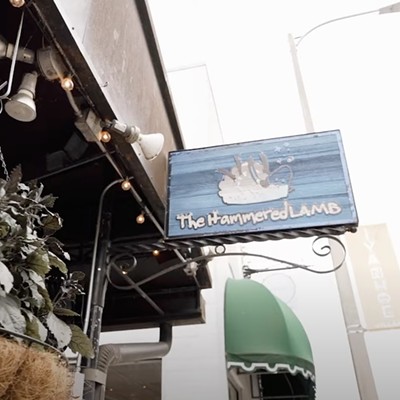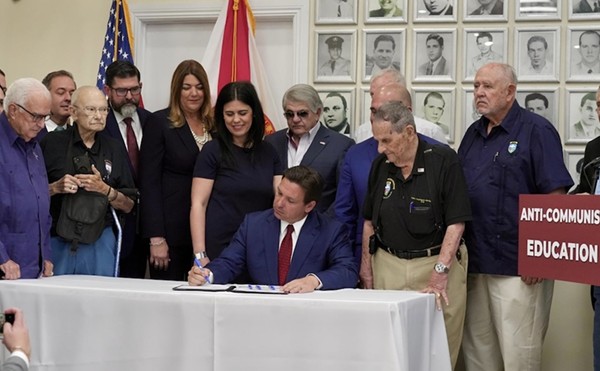Spencer Pigot, 11, was just clocked driving 70 mph. His father has a serious issue on his hands. "He's simply not going fast enough," explains Barry Pigot. "This won't do at all."
The problem is that during the Snap-On Stars of Karting National Championship, the de facto go-karting championship hosted by Disney World in November, Spencer is running 11th in his class. The young Pigot, from Windermere, is one of the 200 best go-kart racers in the country and is competing for a slice of the $500,000 in prizes being handed out this weekend.
"It's not his fault, though," Barry is quick to point out. "He's driving a new chassis we just brought over from Italy and it just isn't working."
Pigot's cadet-class go-kart (for 8- to 12-year-olds) does 0-60 mph in five seconds, and will hit 70 mph at the end of the front straight. He races wheel-to-wheel in a pack of 30 karters, pulling two Gs in the corners.
On the other side of the paddock and 30 years away is Gary Willis, 41. Ralph Lauren and Ralph Nader don't contrast as much as Willis and Pigot. The boy has an exquisitely painted carbon-fiber helmet, monogrammed undershirt, protective racing boots and a crisp racing uniform that makes him look like a world champion-in-waiting. The man has an unadorned black helmet, a baggy oil-stained suit, and a pair of white Reebok tennis shoes. He doesn't want to look cool; he just wants to go fast. Both plans are working out.
Willis, from Orlando, is the oldest driver here, by maybe 15 years. Still, he thinks he has a shot. He's been racing for 20 years, and just opened a kart shop in Orlando, Prime Motor Sport.
"I'm just trying to make a living doing what I love and I plan to race as long as I'm competitive," he says after posting the fourth fastest time in his class. Considering that about 25 fearless 16- to 21-year-olds with big dreams were well behind him, Willis could be racing for a while.
Six classes of karts are here at Disney's Wide World of Sports Complex, ranging from Spencer's Cadet class, to the hairy ICC Shifter class, a small step above Willis' ICA class.
In a racing kart the driver sits virtually on the ground, in the middle of the kart, which is about as wide as it is long. While the Cadets are quick, the ICC karts are scary. An ICC kart does 0-60 mph in 3.5 seconds – about twice as fast as a 2004 Ford Mustang GT.
To balance this, ICC Shifter karts brake hard enough to simulate a head-on collision. You actually have to push against the steering wheel to stay seated under maximum braking, as go-karts don't have seat belts.
That last fact surprises a lot of people.
"Well, hell, you're only one-half inch off the ground. The worst that can happen is that you're ejected and you roll. A lot," an ICC driver told me, pointing out deep scratches in his nylon racing suit.
Racing karts ride on extra-wide tires that are sticky enough to make flypaper seem slick. ICC karts corner so hard that it is easy to crack a rib from turning. To protect themselves, all the drivers wear rib shields that look like Vietnam-era flak jackets under their race suits. As a result, suited-up karters appear to be a portly bunch.
Most karters, like race-car drivers in general, come in one of two sizes: small or extra-small. Even in the top classes, anyone weighing over 180 pounds faces a huge weight penalty. Weighing less lets you position ballast to the most advantageous areas on the kart; weighing more means you are the ballast, and that kart racing may not be for you.
The Stars series is for aspiring road racers, which means that the racecourse has both left- and right-hand turns. Aspiring NASCAR drivers start elsewhere. The heroes to Pigot and most of the kids here are Formula One and Champ Car drivers like Michael Schumacher, Jenson Button and Paul Tracy.
As one French-Canadian competitor put it, "Naz-cair? No. Formula One is the dream."
LET'S RACE
Barry Pigot is in the paddock and is clearly perplexed that his son is out of the top 10 on the timesheets. Barry reasons that any farther down the order and Spencer might as well start the race in Tampa. He decides to make a change for Saturday's qualifying race. The new kart from Italy has to go.
"Spencer has the talent," Barry asserts. "He won a national championship last year in a series where all the karts are perfectly equal. We just have to give him a good kart."
In Spencer's Cadet class, as in five of the six classes present this weekend, the karts are not necessarily equal. You are free to try different chassis, engine builders, etc., which encourages innovation. And innovation, of course, encourages spending money. Cubic feet of money. At the national-championship level, a committed family can spend $50,000 or more for a season of kart racing. As any racer will tell you, "Money equals speed – how fast do you want to go?"
Saturday morning comes and Willis is looking for that little something extra, the "unfair advantage," as racers call it, that will propel him to the front of the pack. Not cheating, mind you; more like meticulous preparation to the very limit of the rules.
"We're just tinkering right now; we're going to try going up a gear to get a better jump off the corners. We'll see what happens with that," Willis explains.
The rest of the weekend's racing is divided up into Saturday morning qualifying, a Saturday afternoon heat race and the Sunday main event. Sunday's race is the only one that counts, but not qualifying well is pretty much a terminal condition.
Back on the other side of the paddock, Barry Pigot looks like someone who just had the Extreme Makeover: Home Edition truck pull into his driveway.
"Yes, yes!" he says. "Spencer is up to fifth in the morning qualifying with the old chassis! It was a huge improvement. Much better!"
Overnight, the kart-racing team that Barry hired had moved Spencer's motor and ancillary items from the new but unproductive kart into the kart he'd used most of the season.
It's hard to believe that a different kart chassis – which looks like a bunch of tent poles assembled in the shape of a cooking grill – could make that much difference.
"How much time did he actually gain?" I ask.
"Well," Barry explains proudly, "it was about three-tenths of a second per lap. All the difference in the world, really."
Willis, meanwhile, holds on to his fourth place in qualifying, much to the chagrin of those 26 career-minded youngsters behind him who have to explain to their teams why they're getting their asses kicked by someone in Reeboks who's almost old enough to enroll in AARP.
The Stars of Karting series itself isn't even as old as the youngest karters here. It was founded just four years ago by Bryan Herta, a veteran driver on Michael Andretti's Indy car team.
"When we started, it was just a one-off event in Vegas to see if anyone would show up. I knew it had potential, but it really took off quickly. Prior to that, karting in the U.S. was not terribly well organized at the national level," Herta explains.
In fact, prior to the Stars series, national karting was all but nonexistent and aspiring karters had no established path into auto racing. The series is now owned and run by Herta and partner Bobby Rahal, the 1986 Indy 500 winner, and sponsors are starting to line up, providing the $500,000 in prizes up for grabs this weekend.
For the Saturday heat races, the Cadets go first. Barry Pigot watches through a chain-link fence – only one mechanic per racer is allowed in the pits for the races – as Spencer dons his helmet and settles in to the kart. The starter calls time, and the Cadet karts are fired and sent on track.
Thirty karts make their way down the 710-foot front straight, and even though it's only the formation lap, they are practically on top of each other. Barry Pigot, watching from 50 yards away, is anxious as hell. "This does set the grid for the championship race; it's very important," he says.
The starter waves the green flag as though his pants were on fire, and the sound ratchets up as the Cadets take off. A few karters lose the race at the first corner, spinning to an unrecoverable stop. Fortunately, Spencer isn't among them. He's jockeying for position and at every lap, Barry is clocking him and craning for a better look.
The view isn't so good at this point, as Spencer is starting to drop back despite fighting like a tiger. He slips to 11th before passing three cars on the last lap to finish eighth, the position he'll start in the championship race Sunday.
Spencer tells his dad that the other karts were pulling away on the front straight, which means he's down on power. It's a tough problem to overcome this late in the game.
Willis' heat race is uneventful, though he loses one spot when his tires start slipping near the end. He'll start his championship race from fifth position.
"I think we got it figured out," he tells me after the race. "I'm gonna lower the ride height a bit and that should do it."
Lower? It doesn't look possible to slide a credit card under his kart as it sits.
THE MAIN EVENT
Sunday morning dawns and the racers are allowed a practice session before the championships. Pigot's practice might have helped improve the kart a bit, but the situation is a little different in Willis' tent.
"How did the ride height change work out?" I ask.
"We don't know," he says while continuing to wrench on the kart.
"What happened?"
"Well," Willis looks up with his friends looking on, "the, umm, carburetor fell off," he says solemnly.
His buddies start to laugh and snort a bit at this and he shoots them a "yeah, real fucking funny" look.
The championship races start right on time, after the single worst rendition of the national anthem ever broadcast. Apparently an actual singer was not in the budget, so a male employee of the Stars series took the mike, to everyone's regret.
The Cadet race came first and Spencer made a lively run at it, advancing several positions early before starting a slow drop through the field. The performance was clearly puzzling to the elder Pigot; the boy was making a go of it in the corners, but always had a big gap to the kart in front of him on the straight.
After the race, Spencer and his father had a talk while walking back to the paddock.
Willis fared a little better. His carburetor did not fall off a second time, and he fought to gain third, then slipped a bit late in the race to finish sixth, still leaving 24 youngsters scratching their heads.
"That change we made took us the wrong direction," Willis says back in the paddock. "Of course we'd have found that out ahead of time if the carburetor hadn't fallen off. That's racing for you."
With the season over, Barry Pigot and his wife, Shelby, are going to talk to Spencer about what he'd like to do next.
"If he says he wants to try soccer, that's the direction we'll go. We'll let him decide," Shelby says with a smile.
"If racing is in his heart?" I ask.
"I think we can accommodate that," Barry says, smiling as well.
Willis plans to contest the entire Stars series next year. He hopes to sell some of the new Gillard chassis that have worked so well for him, and prepare karts for younger drivers. It's something of an "if you can't beat him, might as well join him" message that probably wasn't lost on the kids who finished behind him.



















